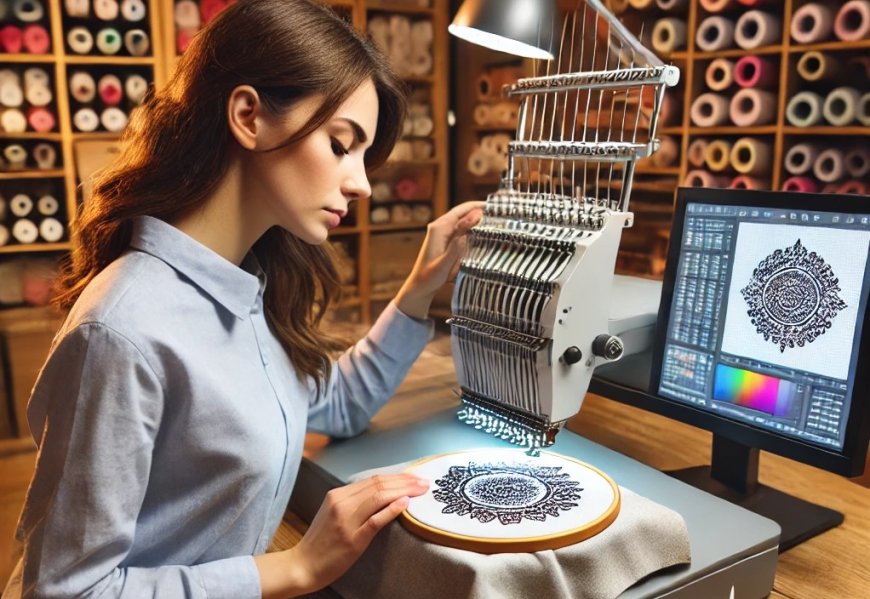Enhance Your Merch with Custom Embroidery Digitizing Services

If you're looking to take your merchandise to the next level, custom embroidery digitizing is a game-changer. Whether you're running a small business, managing a corporate brand, or just creating personalized gifts, high-quality embroidery makes your products stand out. But here’s the thing—great embroidery starts with great digitizing. In this article, we are going to discuss the benefits of custom embroidery digitizing services.
What Is Embroidery Digitizing?
Embroidery digitizing is the process of converting a design into a digital file that an embroidery machine can read. Think of it like giving the machine a step-by-step map—where to stitch, what colors to use, and in what order. Without proper digitizing, even the coolest designs can end up looking messy or distorted.
Why Does Digitizing Matter?
Ever seen an embroidered logo where the threads bunch up, the letters are hard to read, or the colors bleed into each other? That’s usually a digitizing problem. Good digitizing ensures:
- Clean, crisp details – Small text and fine lines stay sharp.
- Proper stitch density – Too many stitches can make the design stiff; too few can make it look patchy.
- Correct thread tension – Prevents puckering or loose threads.
- Efficient stitching order – Reduces thread breaks and machine errors.
In short, digitizing is what separates professional-looking embroidery from DIY disasters.
How Custom Embroidery Digitizing Works
If you’re new to this, here’s a quick breakdown of how the process usually goes:
- You Provide the Design – This could be a logo, artwork, or even a sketch. The clearer the image, the better the digitized result.
- The Digitizer Analyzes the Design – They determine stitch types (satin, fill, running stitch), underlay needs, and optimal thread colors.
- The File Gets Programmed – Using specialized software, the digitizer creates a file (common formats include .DST, .PES, .EXP) that tells the embroidery machine exactly how to stitch the design.
- Test Run – A good digitizer will stitch out a sample to check for errors before finalizing.
- Final File Delivery – You get a machine-ready file to use for production.
DIY vs. Professional Digitizing
Sure, there are auto-digitizing tools out there, but they often produce mediocre results. Professional digitizers manually adjust stitch angles, densities, and pull compensation to ensure the design looks perfect on fabric. If you want your merch to look polished, investing in professional digitizing is worth it.
Best Uses for Custom Embroidered Merch
Wondering where embroidered designs work best? Here are some top applications:
Apparel Branding
- Hats & Caps – Embroidered logos on hats are classic and durable.
- T-Shirts & Polos – Gives a premium, long-lasting look compared to prints.
- Jackets & Hoodies – Embroidery holds up better than screen printing on thicker fabrics.
Corporate & Promotional Items
- Employee Uniforms – Reinforces brand identity with a professional touch.
- Tote Bags & Backpacks – Great for giveaways or retail merchandise.
- Patches & Badges – Custom patches can be sewn onto almost anything.
Personalized Gifts
- Baby Onesies – Cute embroidered names or designs.
- Towels & Blankets – Adds a custom, high-end feel.
- Pet Bandanas & Collars – Because even pets deserve stylish merch.
Choosing the Right Digitizing Service
Not all digitizing services are equal. Here’s what to look for:
- Experience – Check reviews and sample work.
- Turnaround Time – Some offer rush services if you’re on a deadline.
- Revisions Policy – A good service will tweak the file if the test stitch has issues.
- File Compatibility – Ensure they provide files for your specific embroidery machine.
Cost Factors in Embroidery Digitizing
Prices vary based on:
- Design Complexity – More colors and details = higher cost.
- Stitch Count – Larger designs with more stitches take longer to digitize.
- Urgency – Need it fast? Rush jobs may cost extra.
While you might find cheap digitizing online, remember—you often get what you pay for. A poorly digitized design can waste time, thread, and fabric.
Tips for Getting the Best Results
To ensure your embroidered merch turns out flawless, follow these tips:
Start with a High-Quality Image
- Vector files (AI, EPS) work best. If you only have a JPEG or PNG, make sure it’s high-resolution.
Keep Design Details in Mind
- Tiny text (under ¼ inch) may not stitch well.
- Avoid overly complex gradients—embroidery works best with solid colors.
Choose the Right Fabric
- Stitches behave differently on cotton vs. polyester vs. denim. Let your digitizer know what material you’re using.
Test Before Mass Production
- Always stitch a sample to check for errors before running a full batch.
The Future of Embroidery Digitizing
With advancements in software and automation, digitizing is becoming more precise and efficient. Some newer tools even use AI to suggest optimal stitch paths. However, human expertise still plays a huge role in perfecting designs for different fabrics and applications.
Final Thoughts
Custom embroidery digitizing is the secret behind high-quality embroidered merch. Whether you're branding apparel, creating corporate uniforms, or making personalized gifts, a well-digitized design ensures durability, professionalism, and eye-catching appeal.
Skip the guesswork and invest in professional digitizing—your merch (and customers) will thank you. Ready to get started? Find a trusted digitizing service today and watch your designs come to life with flawless stitching.









































